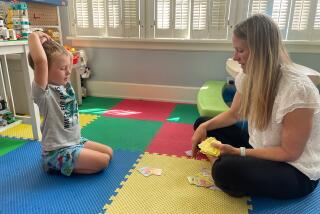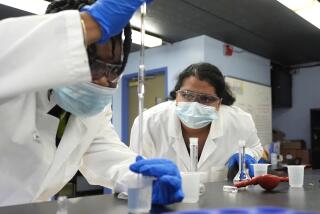Just How Resilient Can We Expect Kids to Be?
- Share via
It’s comforting to think that children are survivors. If adults have dealt them a losing hand--if they fail to nurture them, fail to teach them, fail to help their parents find jobs--it is comfortable to believe that with enough pluck and character, they will pull themselves up by their own sneaker laces.
There are plenty of examples of people who grew up under adverse conditions and later built happy and productive lives as adults. But an emerging group of “resiliency” experts says it’s not simply a matter of inner resources.
San Diego psychologist Mark Katz, who has written a book on resiliency--”On Playing a Poor Hand Well” (W.W. Norton & Co., 1997)--said, “There are many factors from within and without that need to come together in order to help children and families overcome the conditions they’re up against.”
Katz said that after decades of studying survivors, researchers have identified some basic factors that promote resiliency:
* A sudden turning point that can occur at any time in life, such as an unexpected life path or a positive intimate relationship.
* A sense of mastery that teaches that efforts are connected to outcomes, and shows they are good at something that people who are important to them admire.
* Words to describe their hardship in a way that validates the pain they’ve endured and lets them know they’re not helpless or hopeless.
* Buffers from the adverse conditions that surround at-risk children, such as high-quality schools and mentors.
Those who don’t survive hardships have usually been exposed to four or more “risks,” such as abuse, domestic violence, learning disabilities or poverty, Katz said. “It’s almost always multiple things, and they persist. This is why the buffering influence is so significant.
“We have a culture that strongly believes everyone can pick themselves up by their own bootstraps if they just try hard enough or are smart enough,” Katz said. “But research shows that if there are seven or more risks, you probably won’t find any resilient children.”
One study found that more than half of 500 children who had been exposed to four or more risks struggled throughout their childhood, Katz said. But by the time they reached their early 30s, at least half of them had turned their lives around.
Recently, the researchers have gained attention by applying their findings to prevention programs.
“A lot of it is common sense,” said Tim Duffey, a former teacher and founder of Common Ground in Prevention, a Gorham, Maine, corporation that holds conferences and seminars in resiliency. “It affirms what good parenting, good education, good community living has been about, but what we’ve tended to lose sight of.”
Duffey said many school programs or community initiatives are simply a matter of looking at troubled children in a more positive light. For instance, some neighbors in a Colorado suburb have started an initiative called Wrap Your Arms Around Cherry Creek Kids, with billboards and fliers carrying positive messages. In Vermont, a “resilience network” is helping the Department of Education retool its grant process so programs address resiliency traits rather than problems.
Some Utah researchers are applying resiliency to people with asthma, the elderly and businesses, Duffey said.
The resiliency movement is as much a philosophy as anything else, he said. “It’s about being there, caring for kids, making connections. It’s much more about establishing relationships than building new programs.”
* Lynn Smith’s column appears on Sundays. Readers may write to her at the Los Angeles Times, Life & Style, Times Mirror Square, Los Angeles, CA 90053, or via e-mail at lynn.smith@latimes.com. Please include a telephone number.


